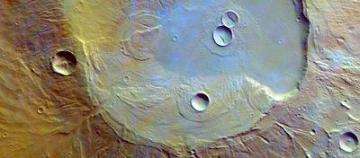Ancient caldera in Apollinaris Patera

These images, taken by the High Resolution Stereo Camera (HRSC) on board ESA's Mars Express spacecraft, show the caldera of Apollinaris Patera, an ancient, 5-kilometer-high volcano northwest of Gusev Crater.
The HRSC obtained these images during orbit 987 with a ground resolution of approximately 11.1 meters per pixel. The images show part of Apollinaris Patera, a volcano lying at approximately 7.2° South and 174.6° East. Apollinaris Patera is an ancient shield volcano located at the northern edge of the Southern Highlands, lying to the south-east of Elysium Planitia and to the north of Gusev Crater, which is now being explored by NASA's Mars Rover, Spirit.
The volcano measures approximately 180 by 280 kilometers at its base and rises to a maximum of 5 kilometers above the surrounding terrain.
Shield volcanos are large volcanic structures with gently sloping flanks. The caldera of Apollinaris Patera takes the form of a large crater approximately 80 kilometers in diameter and up to 1 kilometer deep. Volcanic calderas are formed when a volcano explodes or when the cone collapses.
In the true-color image, the terrain is partly covered by thin, diffuse, whitish-appearing clouds. In the false-color image, the clouds appear as bluish-tinted areas. The western region of the color image (top of the image, as north is to the right) is characterized by brighter material, which seems to be layered and could be the result of sedimentary deposition. Distinct layering, causing a terrace-like appearance, is also visible east of this brighter material and in the relatively flat region located in the northwest (top right) of the color image.
The color scenes have been derived from the three HRSC-color channels and the nadir channel. The anaglyph image was calculated from the nadir and one stereo channel. Image resolution has been decreased for use on the internet.
Source: European Space Agency





















